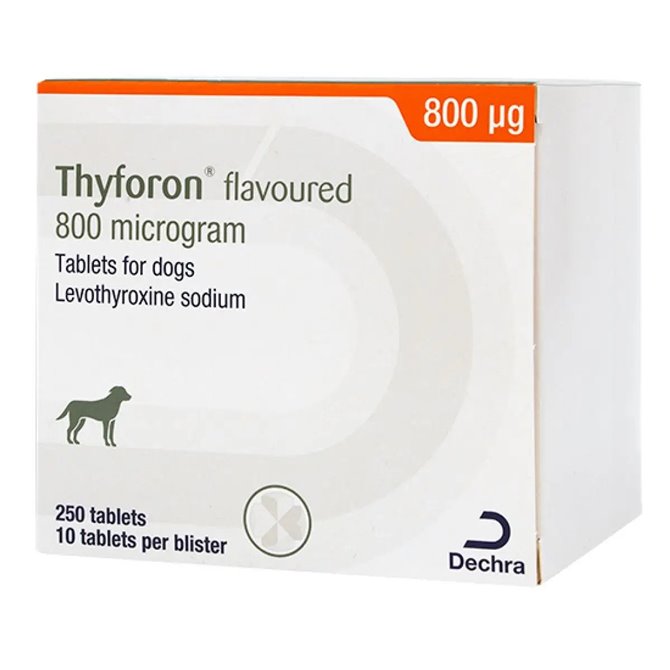
Thyforon 800 Tablet for Dogs - per Tablet
710301
Thyforon 800 is a prescription medication used to treat hypothyroidism in dogs. Each tablet contains 800 micrograms of levothyroxine sodium, a synthetic form of the thyroid hormone thyroxine (T4). This medication helps restore normal thyroid hormone levels in dogs with an underactive thyroid, supporting their overall health and well-being. Thyforon 800 is designed to be easily administered and provides consistent hormone replacement therapy for dogs diagnosed with hypothyroidism.
How Thyforon 800 Works
Thyforon 800 contains levothyroxine sodium, a synthetic version of the T4 hormone that the thyroid gland naturally produces. In healthy dogs, the thyroid gland regulates metabolism, energy production, and organ function. When a dog has hypothyroidism, its thyroid does not produce enough hormones, leading to various health problems.
Levothyroxine sodium works by supplementing the missing hormone, restoring normal thyroid function. Once administered, the medication is absorbed into the bloodstream and converted into triiodothyronine (T3), the active thyroid hormone. This conversion allows the dog’s body to regulate metabolism, energy levels, skin health, and organ function as it would in a healthy thyroid state.
Product Features
- Pack Size: - Sold Individually
- Target Animal: - Dog (Canine)
- Related Condition: - For the treatment of hypothyroidism in dogs
- Pet Prescription Required?: - Yes (For UK Orders)
- Active Ingredient: - Levothyroxine Sodium
- Product Name: - Thyforon 800 (Forthyron) Tablet for Dogs - per Tablet
More Information
Description
Thyforon may only be supplied with a valid veterinary prescription issued by your vet. You should only purchase Thyforon if you have or are in the process of arranging such a prescription. See information bar for further details.
Signs of Hypothyroidism in Dogs
Hypothyroidism is a common endocrine disorder in dogs, primarily affecting middle-aged and older dogs. It occurs when the thyroid gland fails to produce enough thyroid hormones, leading to a range of symptoms.
Some of the most common signs of hypothyroidism in dogs include:
- Weight gain despite no change in diet
- Lethargy and reduced energy levels
- Hair loss, often on the body and tail
- Dry, flaky skin and increased shedding
- Slow heart rate
- Intolerance to cold temperatures
- Thickened or darkened skin
- Recurrent skin infections
- Mental dullness or depression
These symptoms develop gradually and may be mistaken for normal ageing. If left untreated, hypothyroidism can lead to severe complications, including heart problems, neurological issues, and decreased quality of life.
Which Dogs are at Risk of Hypothyroidism?
Hypothyroidism can occur in any breed, but some dogs are more predisposed to the condition. Medium and large breeds are more commonly affected, and the disease typically develops in middle-aged dogs. Some breeds known to have a higher risk include:
- Golden Retrievers
- Labrador Retrievers
- Doberman Pinschers
- Boxers
- Cocker Spaniels
- Irish Setters
- Great Danes
Neutered male and female dogs are also at a slightly higher risk of developing hypothyroidism. The condition is not contagious and is usually caused by autoimmune disorders or glandular atrophy, where the thyroid gland gradually deteriorates over time.
Administering Thyforon 800
Thyforon 800 is available in flavoured tablets to make administration easier. The dosage is determined by a veterinarian based on the dog's weight, thyroid hormone levels, and overall health condition. The tablets are usually given once or twice daily, depending on the veterinarian's recommendation.
It is important to give Thyforon 800 at the same time each day and follow the prescribed dose. Regular monitoring and blood tests are necessary to ensure that the medication is working effectively. If a dose is missed, it should be given as soon as possible unless it is close to the next scheduled dose.
Possible Side Effects of Thyforon 800
Thyforon 800 is generally well tolerated, but some dogs may experience mild side effects. These are often related to overdosage and include:
- Increased thirst and urination
- Restlessness or hyperactivity
- Increased heart rate
- Diarrhoea or vomiting
- Weight loss despite normal feeding
If any of these symptoms occur, a veterinarian should be consulted to adjust the dosage. Long-term use of Thyforon 800 requires routine blood tests to ensure the correct hormone levels are maintained.
Importance of Regular Monitoring
Dogs receiving Thyforon 800 require ongoing monitoring to ensure the medication remains effective. Regular veterinary check-ups and blood tests help determine if adjustments to the dosage are needed. Thyroid levels may fluctuate over time, requiring periodic changes to the treatment plan.
In most cases, dogs with hypothyroidism require lifelong medication. With consistent treatment and monitoring, affected dogs can live healthy, active lives. Owners should watch for any changes in their dog’s behaviour or health and report concerns to their veterinarian.
Storage and Handling of Thyforon 800
Thyforon 800 should be stored in a cool, dry place away from direct sunlight. The tablets should be kept in their original packaging and out of reach of children and pets. Unused or expired medication should be disposed of safely, following veterinary or pharmacy guidance.
Legal category
Thyforon is a POM-V (Pet Prescription Required)
You may also like
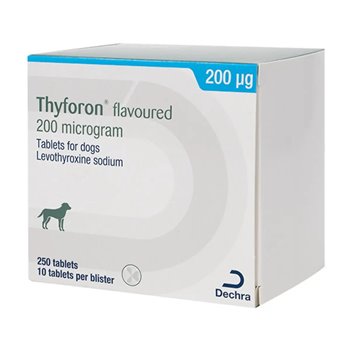
Thyforon 200 Tablet for Dogs - per Tablet
Thyforon 200 is a veterinary medication used to treat hypothyroidism in dogs. It contains levothyroxine sodium, a synthetic form of the thyroid hormone thyroxine (T4), which is essential for regulating metabolism, energy levels, and overall health. Thyforon 200 is available in tablet form and is prescribed by veterinarians to manage thyroid hormone deficiencies in dogs.
Hypothyroidism is a common endocrine disorder in dogs, leading to symptoms such as weight gain, lethargy, hair loss, and skin problems. Thyforon 200 helps restore normal thyroid hormone levels, alleviating these symptoms and improving the dog’s quality of life.
How Thyforon 200 Works
Thyforon 200 contains levothyroxine sodium, a synthetic version of thyroxine (T4), which is the hormone naturally produced by the thyroid gland. In dogs with hypothyroidism, the thyroid gland does not produce enough thyroxine, resulting in a slow metabolism and a range of health problems.
When administered as prescribed, Thyforon 200 supplements the missing thyroid hormone, restoring normal metabolic function. The body converts levothyroxine into triiodothyronine (T3), the active form of the hormone. This process helps regulate energy levels, body temperature, heart rate, and overall well-being.
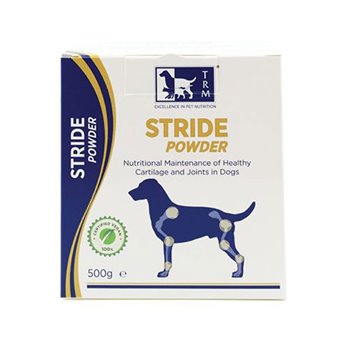
Stride Powder for Dogs with Glucosamine & Chondroitin - 500g
STRIDE Powder is a complementary feeding stuff for the nutritional maintenance of healthy cartilage and joints in dogs. STRIDE Powder contains glucosamine chondroitin and MSM for supporting healthy hips and joints. It also contains manganese sulphate and vitamin C which helps maintain healthy connective tissue formation.
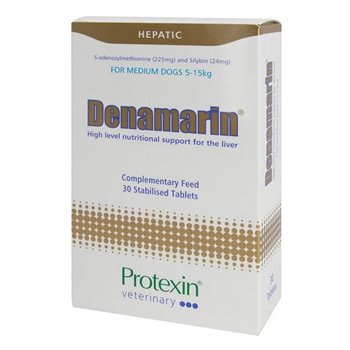
Protexin Denamarin Liver Supplement 225mg Tablets for Medium Dogs - Pack of 30
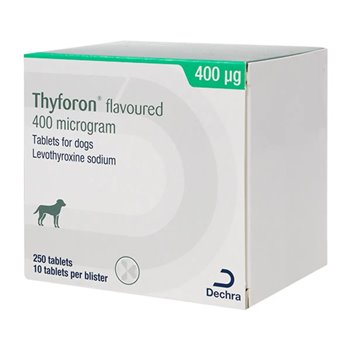
Thyforon 400 Tablet for Dogs - per Tablet
Thyforon 400 is a veterinary medication designed to treat hypothyroidism in dogs. It contains levothyroxine sodium, a synthetic form of thyroxine (T4), which replaces the deficient thyroid hormone. This condition affects a dog’s metabolism, energy levels, and overall well-being. Thyforon 400 helps restore thyroid hormone levels, alleviating symptoms and supporting normal physiological functions.
Hypothyroidism is a common endocrine disorder in dogs, typically caused by autoimmune destruction of the thyroid gland or idiopathic atrophy. The condition results in a slowed metabolism, weight gain, lethargy, and poor coat quality. Thyforon 400 is a prescription medication and must be administered under veterinary supervision.
How Thyforon 400 Works
Thyforon 400 contains levothyroxine sodium, which acts as a replacement for thyroxine (T4), the hormone normally produced by the thyroid gland. Thyroxine is essential for regulating metabolism, body temperature, cardiovascular function, and skin and coat health.
When a dog has hypothyroidism, the thyroid gland fails to produce sufficient hormones, leading to metabolic slowdown and a range of health problems. By supplementing the missing hormone, Thyforon 400 restores normal metabolic activity. The body converts levothyroxine into triiodothyronine (T3), the active form of the hormone, which supports proper organ function and energy regulation.




